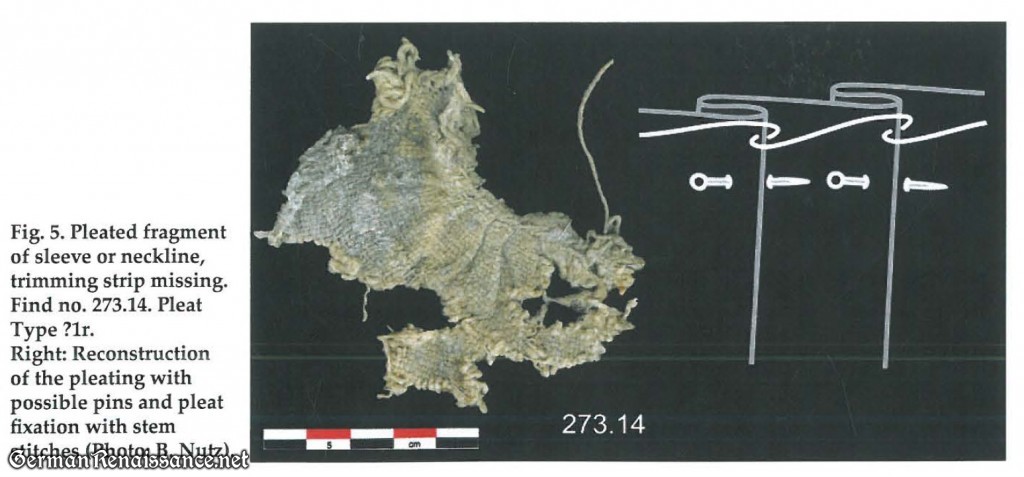Material can be pleated in a variety of ways. The most basic method, and likely the very first method our ancestors ever employed, is to simply fold the material. Let’s look at the research and the actual practice of pleating material using the Fold Method.
Research: Some undergarments were pleated with the fold method, which involves doubling the material upon itself and then pressing, pinning, or stitching in place. Evidence exists to suggest that this method was employed in pleated garments based on the Castle Lengberg finds, specifically Find 273.14 which is a small fragment of a pleated sleeve or neckline with a bit of its trimming strip missing. The raw edge with the missing trimming strip shows indications that the linen was folded at regular intervals (Nutz, 81) and no gathering thread was found. Find 273.14’s pleats were spaced three centimeters (1.2 inches) apart, however, which is very large. While one could create folds in this manner, it produces less-consistently spaced folds and would likely not have been used for shirts with very fine folds (such as those in Find 121 from Castle Lengberg, a section of pleats from a shirt sleeve cuff created in the late 15th century).
Practice: Folding fabric to make pleats is doable, but a bit cumbersome and less precise than the gather method. I don’t recommend this method for pleats with a depth of 1/4″ or smaller, but it works fine for larger pleats. I recommend you dampen your fabric to make it easier for it to keep the folds as you work (and this has the added advantage of keeping the folds better later because the fabric dried that way, too). Here are some pleats using the fold method:
 1/2″ pleats folded and creased by hand
1/2″ pleats folded and creased by hand
 1/2″ pleats folded and stitched
1/2″ pleats folded and stitched
Tip: If you use the fold method to make your pleats, you’ll probably want to iron them to keep them folded as you work on securing them. If that doesn’t seem like enough, consider using white vinegar to keep your pleats folded. To do this, spray a pressing cloth with a 2:1 water/vinegar solution, iron well on the proper setting, then allow to cool. The vinegar chemically sets the folds.
Note: Folded pleats are quite common in outer garments. If you’re looking for a method to make rolled pleats for a skirt, please see my Rolled Pleat Tutorial and Calculator. Cartridge pleats are made using the Gather Method, discussed elsewhere in this guide.
Next up: The Press Method of Creating Pleats
Go to the Introduction (Main Page) or the Table of Contents



Just to let you know – find no. 121 is NOT a section from a collar but the complete cuff of a sleeve (with textile button and button hole still in place).
Thank you! I went back to check your paper, “How to Pleat a Shirt in the 15th Century,” and found that I’d mis-matched the figure to its caption. I’ve corrected the reference to find 121 to indicate it was from a shirt sleeve cuff. I appreciate the correction!